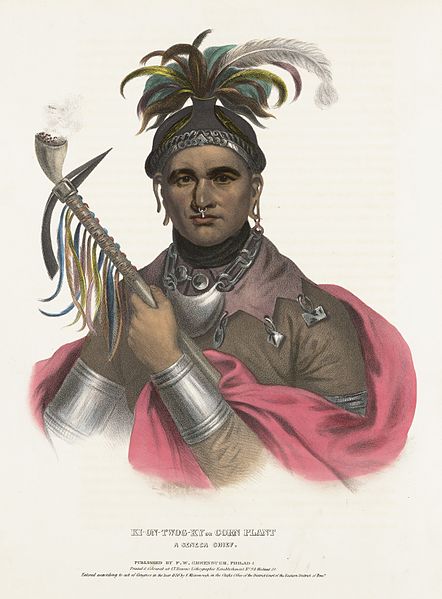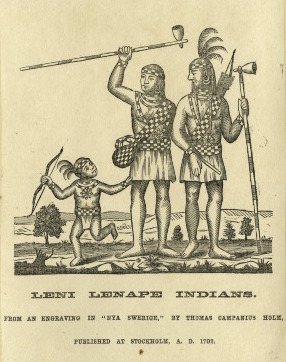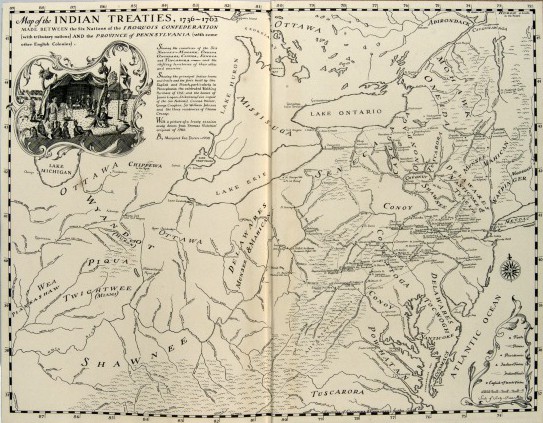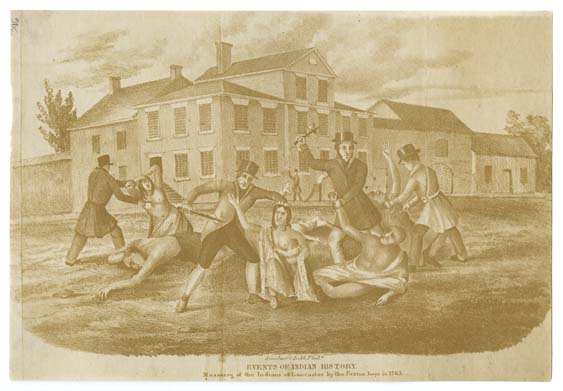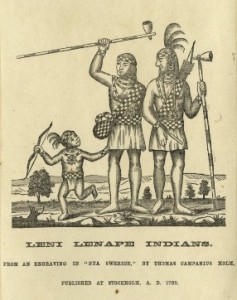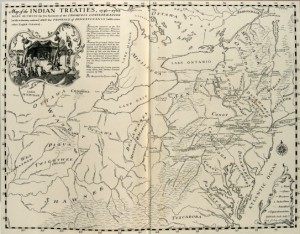Native American-Pennsylvania Relations, 1754-89
Essay
Relations between Pennsylvania’s Native American and European peoples underwent cataclysmic change during the second half of the eighteenth century. Despite the reputation for peaceful intercultural relations that Pennsylvania had enjoyed since its founding in 1681, a series of wars engulfed its frontiers after 1754, leading to the dispossession and exile of the colony’s native peoples. During the Seven Years’ War, which lasted in North America from 1754 to 1760, the colony that William Penn had envisioned as a “peaceable kingdom” became instead the scene of some of the most horrific interracial violence in early America. The disruption of Pennsylvania’s Indian relations caused a deep political rift to open between Philadelphia’s Quaker community and colonists living along the Susquehanna Valley frontier. By the 1790s, Native Americans and Pennsylvania’s European peoples were permanently estranged from each other, and no Indian nations retained secure possession of homelands within the state’s borders.
By 1754, European colonization had substantially altered the location and number of Native Americans in Pennsylvania. The Delawares (also known as Lenapes) had been mostly dispossessed from the river valley that was their original homeland. Despite being stripped of their claim to the Lehigh Valley by the Walking Purchase (1737), some Delawares still lived in that region in Moravian missions while others remained in small towns in central and southern New Jersey. Many Delawares had migrated into the Susquehanna Valley and the Ohio-Allegheny region, which was called the “Ohio country” by colonists. Elsewhere, Indians from the northern Chesapeake Bay and North Carolina migrated into the Susquehanna Valley in the early eighteenth century. By the 1740s, two Indian towns with polyglot populations had become important centers in Pennsylvania’s Indian relations: Conestoga in Lancaster County and Shamokin, at the juncture of the north and west branches of the Susquehanna (modern Sunbury). Farther west, Delawares who settled in the Ohio country were joined there by Shawnees and Senecas who were also drawn to the region by its bountiful resources. Thus, on the eve of the Seven Years’ War, Pennsylvania’s native population included a number of groups that had already experienced the consequences of colonization. By moving into the Susquehanna and Ohio regions, where they amalgamated with each other, these groups established new homelands and new alliances to defend them.
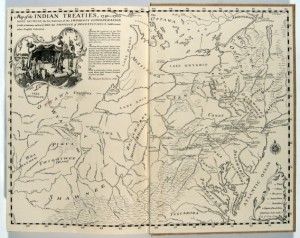
In 1754, the Natives’ claim to these homelands came under attack from several directions. Agents acting on behalf of the Penn family and Connecticut’s Susquehannah Company completed land purchases with the Iroquois Indians of New York who ceded significant portions of western Pennsylvania without any approval from the Indians who lived there. Virginian land speculators raced against the Penn family to lay claim to the Ohio country, again relying on cooperative Iroquois from New York. At the same time, the French asserted their possession of the region by building forts between Lake Erie and the Ohio River. After a British army commanded by General Edward Braddock was defeated by a French and Indian force at the Monongahela River in July 1755, war engulfed the Pennsylvania frontier. Delawares and Shawnees supplied by the French at Fort Duquesne (modern Pittsburgh) raided frontier communities in a broad arc from northwestern New Jersey through the Lehigh Valley to the Juniata River, taking captives, destroying livestock, and killing poorly defended settlers. Pennsylvania’s government responded by instituting scalp bounties that encouraged indiscriminate reprisals against any Indians within the colony’s borders.
Easton Treaty of 1758
A Delaware Indian named Teedyuscung (1700?-1763) emerged as an important intercultural diplomat at a series of treaty conferences convened in Easton, Pennsylvania, between 1755 and 1758. Teedyuscung claimed to represent ten Indian nations, but his chief objective was securing the Delawares’ possession of the Wyoming Valley, along the northern branch of the Susquehanna River (near modern Wilkes-Barre). In negotiations with the Pennsylvanians and other British colonial officials, he asserted the Pennsylvania Indians’ independence from the Iroquois. In this effort, he was supported by Philadelphia Quakers who sought to restore peace by exposing the fraudulent land purchases William Penn’s heirs had made with the Iroquois. Although neither Teedyuscung nor the Quakers succeeded entirely in their mission, the Easton Treaty of 1758 did end Pennsylvania’s Indian war by restoring some of the disputed territory and by promising that the British would evacuate the Ohio country after the French had been defeated.
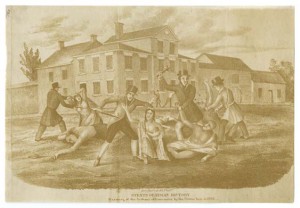
An uneasy peace returned to Pennsylvania after 1758, but the war had permanently altered relations there between native and European peoples. Pennsylvania colonists, despite their ethnic and cultural differences, came to see themselves as sharing a common, racially-defined “white” identity in contrast to the Indians’ “savage” one. In the Ohio country, a Delaware prophet named Neolin (fl. 1760) preached a doctrine of “separate paths,” urging Indians to revive ancient customs and spurn Christianity, alcohol, and other aspects of colonial culture he held responsible for corrupting the native way of life. This revivalist message fueled a pan-Indian resistance to the soldiers and settlers who began moving into the Ohio and Susquehanna regions after 1758. In 1763, renewed hostilities sparked by military occupation and land-grabbing broke out in western Pennsylvania. Pontiac’s War (1763-65) plunged the Pennsylvania frontier into another wave of violence, including an Indian siege at Fort Pitt (the British post built on the site of the old Fort Duquesne), during which British officers discussed using smallpox as a biological weapon against the enemy. In Lancaster County, a group of colonial vigilantes known as the Paxton Boys murdered the Native population of Conestoga Indian Town, which had been allied with the Pennsylvania government since 1701. The Paxton Boys then marched on Philadelphia, threatening to kill Indians from the Moravian missions who had sought refuge there, but intervention by Benjamin Franklin (1706-90) and other city leaders prevented further violence.
By 1765, a decade of warfare had altered the power dynamic in Pennsylvania’s Indian relations. Quakers no longer exerted moral or political authority in the colony’s Indian policy. Instead, frontier settlers assumed all Indians were hostile and tacitly condoned their exile or murder. Speculators from within and outside the colony competed against each other for Indian land, paying little heed to the retrocessions that natives had negotiated at Easton in 1758. At the Fort Stanwix Treaty of 1768, the British Crown’s Indian agent Sir William Johnson (1715-74) conducted yet another land sale with the Iroquois that ceded Delaware and Shawnee homelands without their consent.
The Revolution’s Toll on Indians
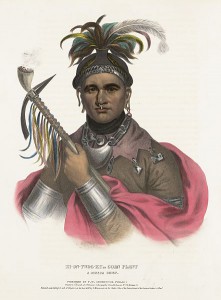
The American Revolution accelerated Indian dispossession in Pennsylvania. Freed from the restraints of British imperial authority, the Americans attacked and uprooted Native populations. A Continental Army expedition in 1779 laid waste to Indian towns in the northern Susquehanna and Allegheny Valleys. In March 1782, militiamen from the Pittsburgh area murdered nearly 100 Delaware men, women, and children in the Moravian mission town of Gnadenhütten in the Ohio country. By the war’s end, nearly every Indian community within Pennsylvania’s borders had either been destroyed or abandoned and their survivors forced to seek refuge in Ohio or New York. The state of Pennsylvania recognized no federal or state Indian reservations within its borders. By the 1790s, only one small Indian community remained within Pennsylvania: a group of Seneca Indians who lived along the Allegheny River on land privately owned by their leader, Cornplanter (c. 1750-1836). Cornplanter’s Town remained on this property until its inhabitants were forced to relocate onto Seneca reservation lands in New York by the construction of the Kinzua Dam in the 1960s.
Despite the fact that Indians and colonists alike often invoked the memory of William Penn in their treaty negotiations, the Quaker founder’s vision of a peaceable kingdom in Pennsylvania never came to fruition. The Penn family’s hunger for Indian land contributed to this deterioration in relations, but other causes included the militarization of Pennsylvania’s frontier after 1754, the unstoppable stream of settlers who invaded Indian territory, and the intrusion of imperial officials and land speculators from other colonies into Pennsylvania’s Indian affairs. Most importantly, after 1754 the mosaic of ethnic identities within Pennsylvania hardened into two separate and diametrically opposed racial categories: white and Indian. Europeans pursued policies that denied natives membership in the Pennsylvania commonwealth, while natives trying to survive the onslaught of colonization decided that their best option was to move beyond the reach of their European neighbors.
Timothy J. Shannon is Professor of History at Gettysburg College in Gettysburg, Pennsylvania. His publications include Indians and Colonists at the Crossroad of Empire: The Albany Congress of 1754 (Ithaca: Cornell University Press, 2000) and Iroquois Diplomacy on the Early American Frontier (New York: Viking Penguin, 2008). (Author information current at time of publication.)
Copyright 2015, Rutgers University.
Gallery
Backgrounders
Connecting Headlines with History
- Oneida Indian Nation gives $10 million for Revolutionary War museum in Philly (WHYY, July 11, 2012)
- Scenes from West Philly's Indigenous Peoples Day [photos] (WHYY, October 7, 2013)
- Lenape take to river to renew community treaties (Pike County Courier, August 4, 2014)
- Landmark $554M U.S.-Navajo settlement made official (WHYY, September 27, 2014)
Links
- Conestoga Indian Town Historical Marker (ExplorePAHistory.org)
- Treaties Between the United States and Native Americans (The Avalon Project)
- Braddock's Defeat Historical Marker (ExplorePAHistory.org)
- Benjamin Franklin, An Account of the Paxton Boys' Murder of the Conestoga Indians, 1764. (ExplorePAHistory.org)
- Respecfully Remembering the Affable One (Hidden City Philadelphia)
